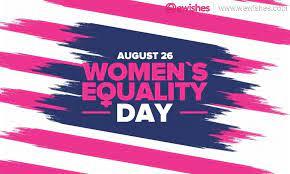The celebration of Women’s Equality Day reminds us of the importance of our nation’s history. People learn from history. That is how we grow and change, and most importantly, that is how we improve.
Women’s Equality Day, celebrated annually on August 26th, commemorates the passage of the 19th Amendment and reminds us of the decades-long struggle of the suffrage movement. For three quarters of a century, a broad and diverse group of women and men worked hard to promote change. The struggle was lengthy and complicated. Women were not always united in their goals, and the movement was interwoven with issues of civil and political rights for all Americans.
There was significant overlap with the abolition movement. After the Civil War, many Americans thought women should support voting rights for African American men first. By the turn of the twentieth century, the movement was divided again by a rivalry between leaders, Alice Paul and Carrier Chapman Catt. Paul led the more radical side while Catt led the more conservative side. Together, however, the suffragists became a powerful political pressure group and a model for the civil rights campaigns to follow in the twentieth and twenty-first centuries.
They utilized a wide range of tactics that were not based on violence, deception, or threats. In return, however, many faced violent opposition and arrest. The brutal treatment they received helped shift public opinion. Marches in Washington D.C. drew visibility, leading more women and men to support female suffrage. During World War I, women took jobs that had long been considered male-only. Although they were fired afterward to make way for the returning men, their patriotic contribution was recognized to the extent that it increased support for women’s enfranchisement.
In 1918, the amendment failed by two votes to gain the necessary two-third majority in the Senate. It was not until the Republican Party gained a majority in 1919 that it passed. When it was ratified by 36 states the very next year, it took some getting used to. There were no national victory parades or official ceremonies for the millions of new women voters, but coast to coast the suffragists celebrated their success, toasting to their long-sought victory. Over eight million women voted in the November presidential election that same year.
To remind us of the struggles of the past, present, and future, Congress designated August 26 as Women’s Equality Day in 1971. The year 2020 marked the centenary of the 19th Amendment’s ratification. The passage of the 19th Amendment represented a breakthrough for American women, as well as a major step forward for American democracy. Reflecting on the suffrage movement, Susan B. Anthony wrote to a friend: “you & I have done the best we knew—and so must rest content—leaving all to younger hands.” Future generations should remember the efforts of these men and women. The suffrage movement teaches us that, together, people can change this country and guide the world toward a better future.
Jessica M. Heinz is a partner in CIPRIANI & WERNER, P.C.’s Philadelphia office and a member of the firm’s Diversity, Equity & Inclusion Committee.

